West Hollywood
West Hollywood in brief- City government in action this week
September events, programs, city services, Free Theatre in the Parks, September as Ovarian Cancer Awareness Month plus more
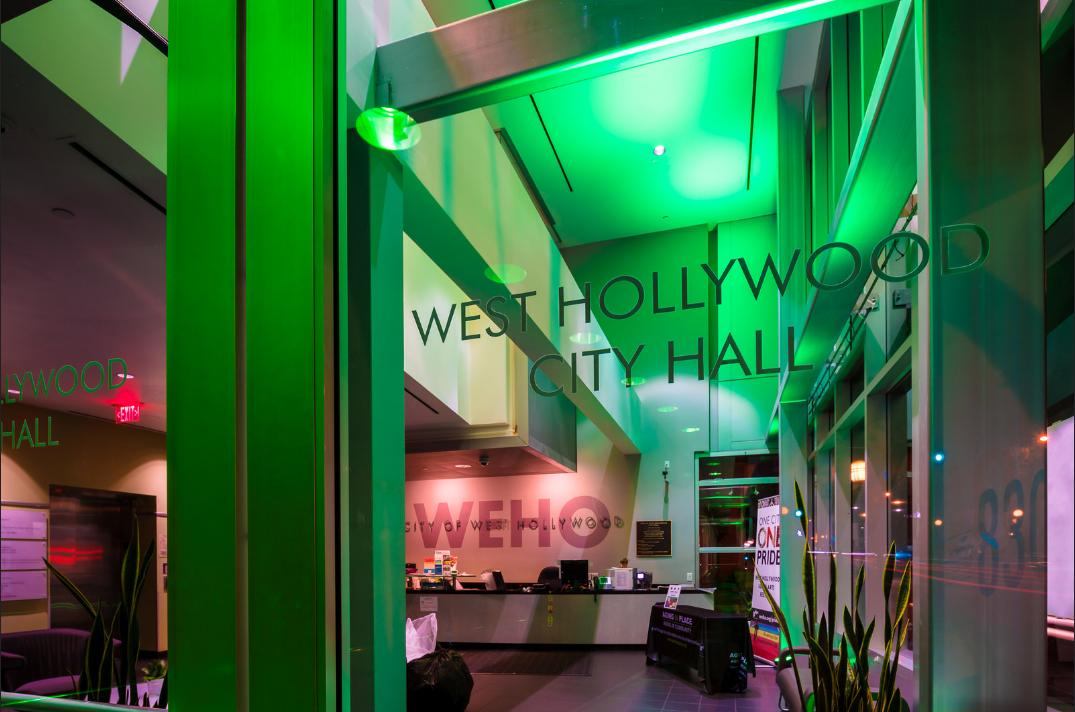
City of West Hollywood to Begin Annual Tree Pruning
WEST HOLLYWOOD – Trees make our cities greener, cleaner, and healthier. The City of West Hollywood has approximately 12,500 trees that require maintenance and care. The City of West Hollywood will begin its annual program of tree pruning on Monday, September 11, 2023 and work is expected to continue through February 2024.
The City’s contractor, West Coast Arborists, is beginning pruning work along Sunset Boulevard, taking care not to disrupt Westbound lanes until after 10 a.m. in order to minimize the impact on morning commute traffic.
During the coming weeks, crews will move to other commercial areas on Santa Monica Boulevard, Beverly Boulevard, and other arterial streets. Following commercial area trimming, work will commence on residential arterial streets. Each day, trimming will start at 8 a.m. and work will be finished by 3 p.m.
The City will communicate to residents, businesses, and motorists in advance of pruning work, using several methods:
- “No parking” signs will be placed a minimum of 24 hours in advance of work. The signs will reflect scheduled trimming activities for each day and they will be broken down into two time segments: before 12 p.m. and after 12 p.m. Parking spaces will be reopened as soon as possible after work is completed;
- Door hangers or postings on trees will be placed a minimum of 72 hours in advance of residential tree-trimming activities;
- Electronic message boards may be placed at strategic locations several days before trimming, as well as during trimming activities, in order to provide commuters with advance notice so they can plan route changes; and
- Notification of trimming activity will be posted on the City’s website and on the City’s social media pages @WeHoCity.
For more information, please contact Sam Estrada, the City of West Hollywood’s Urban Forest and Landscape Maintenance Supervisor, at (323) 848-6867 or at [email protected].
For people who are Deaf or hard of hearing, please call TTY (323) 848-6496.
West Hollywood Recognizes September as Ovarian Cancer Awareness Month
The City of West Hollywood recognizes Ovarian Cancer Awareness Month in September. As part of raising awareness, the City will, from September 1, 2023 through September 10, 2023, light West Hollywood City Hall and the lanterns along Santa Monica Boulevard in West Hollywood in the color teal.
While breast cancer is the most common form of cancer and the second leading cause of cancer death among women in the United States, ovarian cancer is the deadliest of gynecologic cancers, with a mortality rate of more than 50 percent. This is because early ovarian tumors are extremely difficult or impossible for even the most skilled examiner to identify through a normal gynecological exam.
Other screening tools and tests must be employed to detect ovarian cancer in women who don’t have any symptoms, including genetic testing to help determine a woman’s risk or likelihood of developing ovarian cancer.
It is imperative that all high-risk women, even those without symptoms of ovarian cancer, be identified and given the opportunity to receive the most up-to-date screenings as recommended by the United States Preventive Services Task Force (USPSTF).
Despite ovarian cancer rates being highest among white women, Black women are more likely to die from this disease due to lack of access to health care, socioeconomic disparities, and other causes still under study.
All women, regardless of socio-economic status, race, or ethnicity, should be provided with resources needed to protect themselves and their families such as education, outreach, and testing.
The City of West Hollywood has been instrumental in the growth and success of The Ovarian Cancer Circle/Inspired by Robin Babbini since the organization’s inception in 2011. The Circle, founded by Paulinda Babbini, is a nonprofit 501(c)(3) organization aimed at expanding the ring of networking, education and support for women of all ages and their families and friends who may be affected by this disease.
Robin Babbini, Paulinda’s daughter, was the inspiration for The Circle. Robin succumbed to ovarian cancer at the early age of 20. As a teenager she worked for several years as a staff member at the City of West Hollywood for the Tiny Tots and Tot Time Program. Lack of an early diagnosis and access to readily accessible public information concerning ovarian cancer contributed to the advancement of her disease and ultimate death.
Since its inception, The Circle has raised more than $1 million for ovarian cancer research. The West Hollywood City Council will present a proclamation to Paulinda and The Ovarian Cancer Circle/Inspired by Robin Babbini at its meeting on September 18, 2023 in recognition of the extraordinary work they do.
For more information, please contact Jennifer Del Toro, the City of West Hollywood’s Community and Legislative Affairs Supervisor, at (323) 848-6549 or at [email protected].
For people who are Deaf or hard of hearing, please call TTY (323) 848-6496.
West Hollywood Announces Temporary Art Installation: ‘Falling on Deaf Ears’ by Julio Sims at West Hollywood City Council Chambers/Public Meeting Room Lobby Area
The City of West Hollywood will debut the temporary art installation Falling on Deaf Ears by artist Julio Sims on Monday, September 11, 2023 at the City of West Hollywood’s Council Chambers/Public Meeting Room lobby area, located at 625 N. San Vicente Boulevard.
The art installation is part of the City’s Art on the Outside program and it will remain on view at this location through Wednesday, January 10, 2024.
Falling on Deaf Ears by Los Angeles-based artist Julio Sims is a free-standing folding screen mural, measuring 6′ high x 22′ long x 1′ deep, depicting individuals using American Sign Language (ASL) to express the following concept: “What if a tree falls and no one hears?”
The artwork will be installed facing the 22′ length of windows to the left of the building’s entrance and will be viewable from outside the building. The pleated surfaces will display three sets of dual images conveying each ASL sign creating a lenticular effect of the illusion of movement for pedestrian passersby.
Julio Sims is a professional artist based in Los Angeles with four permanent public art commissions in the collection of the City of Los Angeles, the City of Culver City, and the New Roads School in Santa Monica. Sims has exhibited in both solo and group shows in non-profit and commercial art galleries nationally. His visual set designs have also appeared in dance performances internationally.
The Art on the Outside program is the City’s temporary art program that installs rotating artworks throughout the city. The artworks can include sculpture, murals, digital art, and other outdoor works. Most exhibitions remain on display between six months and three years.
All projects are subject to the Art on the Outside Program Review and Approval Process. The program is funded through the Public Beautification & Art Fund.
The City of West Hollywood’s Arts Division delivers a broad array of arts programs including Art on the Outside (temporary public art), Arts Grants, City Poet Laureate, Drag Laureate, Free Theatre in the Parks, Human Rights Speaker Series, Library Exhibits, Summer Sounds + Winter Sounds, Urban Art (permanent public art), WeHo Pride Arts Festival, and WeHo Reads.
For more information about City of West Hollywood arts programming, please visit www.weho.org/arts. For more information, please contact Marcus Mitchell, City of West Hollywood Public Art Administrator, at (323) 848-3122 or at [email protected].
For people who are Deaf or hard of hearing please call TTY (323) 848-6496.
City of West Hollywood Invites the Community to One-Night-Only Pop-Up Art Exhibition: ‘HB7: Cruising’ by High Beams
The City of West Hollywood’s Arts Division will present a one-night-only pop-up art exhibition as part of its Art on the Outside program on Saturday, September 16, 2023 from 5 p.m. to 9 p.m. at Plummer Park’s North Parking Lot. Limited parking will be available at the south entrance to the park, located at 7377 Santa Monica Boulevard.
Presented by High Beams, a Los Angeles-based curatorial collective, HB7: Cruising is a one-night exhibition featuring sculpture, installation, painting, video, and performance artworks by 20 artists. Parking lots have traditionally been stopping points for “cruisers” to meet-up with friends, regroup before a party, or even to hook-up with a sexual partner.
While undeniably tamer than their historical analogs, the “cruisers” expected at HB7 will be able to walk through a temporary art garden that is
wide-ranging and interactive, reflective of a City as diverse as the work, while paying homage to West Hollywood’s legendary nightlife. The themes associated with much of the work are varied, though commonalities include trauma, an impending planetary crisis, body autonomy, and eco-feminism. Other artists have chosen to work with themes around hedonism, pleasure, and simple comfort to distract from the endless parade of anxiety-inducing news.
High Beams is a five-person curatorial group run by artists Carl Baratta, Dani Dodge, Alanna Marcelletti, Sean Noyce, and Katya Usvitsky, who have collectively organized six exhibitions together. Baratta and Usvitsky are also lead curators at Tiger Strikes Asteroid – Los Angeles (TSALA), and have organized
numerous exhibitions around the globe. Baratta is also the lead curator for B-LA Connect, a Berlin-Los Angeles curatorial exchange that includes more than 40 galleries from both cities. Dodge, Marcelletti, and Noyce are lead curators at Durden and Ray, and have also organized exhibitions locally, nationally, and internationally.
The Art on the Outside Program is the City’s temporary art program that installs rotating artworks throughout the city. The artworks can include sculpture, murals, digital art, and other outdoor works. Most exhibitions remain on display between six months and three years. All projects are subject to the Art on the Outside Program Review and Approval Process. The program is funded through the Public Beautification & Art Fund.
The City of West Hollywood’s Arts Division delivers a broad array of arts programs including Art on the Outside (temporary public art), Arts Grants, City Poet Laureate, Drag Laureate, Free Theatre in the Parks, Human Rights Speaker Series, Library Exhibits, Summer Sounds + Winter Sounds, Urban Art (permanent public art), WeHo Pride Arts Festival, and WeHo Reads. For more information about City of West Hollywood arts programming, please visit www.weho.org/arts.
For more information, please contact Marcus Mitchell, City of West Hollywood Public Art Administrator, at (323) 848-3122 or at [email protected].
For people who are Deaf or hard of hearing please call TTY (323) 848-6496.
West Hollywood Presents Free Theatre in the Parks: Pacific Opera Project’s Hansel and Gretel
The City of West Hollywood is bringing back its popular Theatre in the Parks programming with an operatic take on the classic Brothers Grimm fairy tale, Hansel and Gretel, with a magical score by Englebert Humperdinck, playing at Kings Road Park for six-performances-only beginning Saturday, September 9, 2023 at 4 p.m. and running Saturdays and Sundays through Sunday, September 24, 2023. Kings Road Park is located at 1000 N. Kings Road. Attendance is free; seating is first-come first-served. RSVP is requested at https://hanselandgretel-weho2023.eventbrite.com.
This free theatre experience is presented by Pacific Opera Project (POP) and the City of West Hollywood’s Arts Division. Pacific Opera Project’s operatic take on the classic Brothers Grimm fairy tale. Hansel and Gretel is the fantastical story of two siblings lost in an enchanted forest who stumble upon a delicious looking gingerbread house. Little do they know that its owner is an evil witch.
POP’s production of Humperdinck’s Hansel and Gretel is directed by Jack Zager and will feature cast members Milena Gligic, Tiffany Ho, Jared Jones, Christine Li, and Erin Theodorakis. It can be enjoyed by the entire family, with a running time of 75 minutes, and will be sung in English.
Founded in 2011, Los Angeles’s Pacific Opera Project (POP) provides quality opera that is accessible, affordable, and entertaining. POP hosts hundreds of new opera-goers each season, while welcoming back a growing number of opera enthusiasts, producing close to 50 operas in just over 11 seasons.
The City of West Hollywood’s Arts Division delivers a broad array of arts programs including Art on the Outside (temporary public art), Arts Grants, City Poet Laureate, Drag Laureate, Free Theatre in the Parks, Human Rights Speaker Series, Library Exhibits, Summer Sounds + Winter Sounds, Urban Art (permanent public art), WeHo Pride Arts Festival, and WeHo Reads. For more information about City of West Hollywood arts programming, please visit www.weho.org/arts.
For more information about Free Theatre in the Parks, please contact Joy Tribble, the City of West Hollywood’s Arts Specialist, at (323) 848-6360 or at [email protected].
For people who are Deaf or hard of hearing, please call TTY (323) 848-6496.
City of West Hollywood Announces Nick Maricich as New Community Development Director
The City of West Hollywood announces the selection of a new Community Development Director. Nick Maricich will begin at the City of West Hollywood on Monday, September 18, 2023.
Maricich joins the City of West Hollywood with 16 years of service to furthering successful urban planning at the City of Los Angeles. In his most recent role at the City of Los Angeles, Maricich has served as Principal City Planner overseeing functions of the Citywide Policy Planning Division at the Los Angeles Department of City Planning. He also served for five years as the Director of Planning Policy and Development for former City of Los Angeles Mayor Eric Garcetti. He brings a wealth of experience in working with diverse Los Angeles neighborhoods in the areas of community planning and historic preservation. He obtained his bachelor’s degree in Geography with a minor in City and Regional Planning from the University of California, Berkeley, and he holds a master’s degree in Urban Planning from the University of California, Los Angeles.
“Nick’s dedication and innovative approach to community planning and historic preservation during his time at the City of Los Angeles are commendable. His leadership and insights will play a pivotal role in shaping the future of the City of West Hollywood and our community,” said City of West Hollywood City Manager David Wilson. “His unique perspective and proven track record will undoubtedly contribute to our ongoing efforts to create a vibrant and sustainable urban environment for our residents and our city will continue to advance its forward-thinking planning work.”
The City of West Hollywood will schedule a series of Town Hall meetings in September to introduce Nick Maricich to the community, along with speaking with and hearing from community members as the goals and vision of the Community Development Department are advanced under the direction of the new Director.
The City of West Hollywood’s Community Development Department (which for several years had been called Planning & Development Services Department) is responsible for managing the City’s urban environment and creating a livable community that balances the needs of residents, businesses, property owners and visitors.
There are three divisions within the City’s Community Development Department that assist in creating and implementing the community’s vision:
1) Current and Historic Preservation Planning;
2) Long Range Planning; and
3) Building and Safety.
The City’s Community Development Department also serves as a leader in coordinating and focusing multi-departmental work efforts to address the wide number of planning and development concerns in West Hollywood. For additional information about the City’s Community Development Department, please visit www.weho.org/city-government/city-departments/community-development-department.
For more information, please contact Janet Jimenez, City of West Hollywood Administrative Services Director, at (323) 848-6376 or at [email protected].
For people who are Deaf or hard of hearing, please call TTY (323) 848-6496.
City of West Hollywood to Host Historic Preservation Celebration: ‘Plummer Park Through the Years’
The City of West Hollywood’s annual Historic Preservation Celebration, Plummer Park Through the Years, will celebrate the stories, events, and memories that have unfolded within the historic buildings of Plummer Park. The event will take place on Saturday, September 9, 2023, at 11 a.m. at Plummer Park’s Fiesta Hall, located at 7377 Santa Monica Boulevard. Admission to the event is free and open to the public; refreshments will be served.
In addition to the City’s annual historic preservation celebration, the City has partnered with the California Preservation Foundation for their second annual Doors Open event. Great Hall, Long Hall, and Fiesta Hall will be open from 12 p.m. to 3 p.m. where attendees will have an opportunity to learn more about the groups that have played a pivotal role in fostering community unity within the historic buildings of Plummer Park.
The City of West Hollywood, which was incorporated in 1984, recognizes and values the importance of preserving its cultural resources. The City’s Current and Historic Preservation Planning Division works with the City’s Historic Preservation Commission to identify and protect historic resources in West Hollywood. The City adopted an Historic Preservation Ordinance in 1989 and it has designated over 100 structures as cultural resources. For more information about the City of West Hollywood’s historic preservation efforts, please visit the City’s Historic Preservation website at www.wehopreservation.org.
For more information about the Historic Preservation Celebration or about historic preservation efforts in the City of West Hollywood, please contact Doug Vu, City of West Hollywood Senior Planner, at (323) 848-6318 or [email protected].
For people who are Deaf or hard of hearing, please call TTY (323) 848-6496.
***************************************************************************************
For more information, please call the City of West Hollywood’s City Council Offices at (323) 848-6460. For people who are Deaf or hard of hearing, please call TTY (323) 848-6496.
For up-to-date information about City of West Hollywood news and events, follow @wehocity on social media, sign-up for news updates at www.weho.org/email, and visit the City’s calendar of meetings and events at www.weho.org/calendar.
West Hollywood
Administration refused to honor World AIDS Day; residents gathered with defiance, grief and love
Yesterday, members of the APLA Health Writers Group read moving stories to a large group of locals gathered at the AIDS monument.
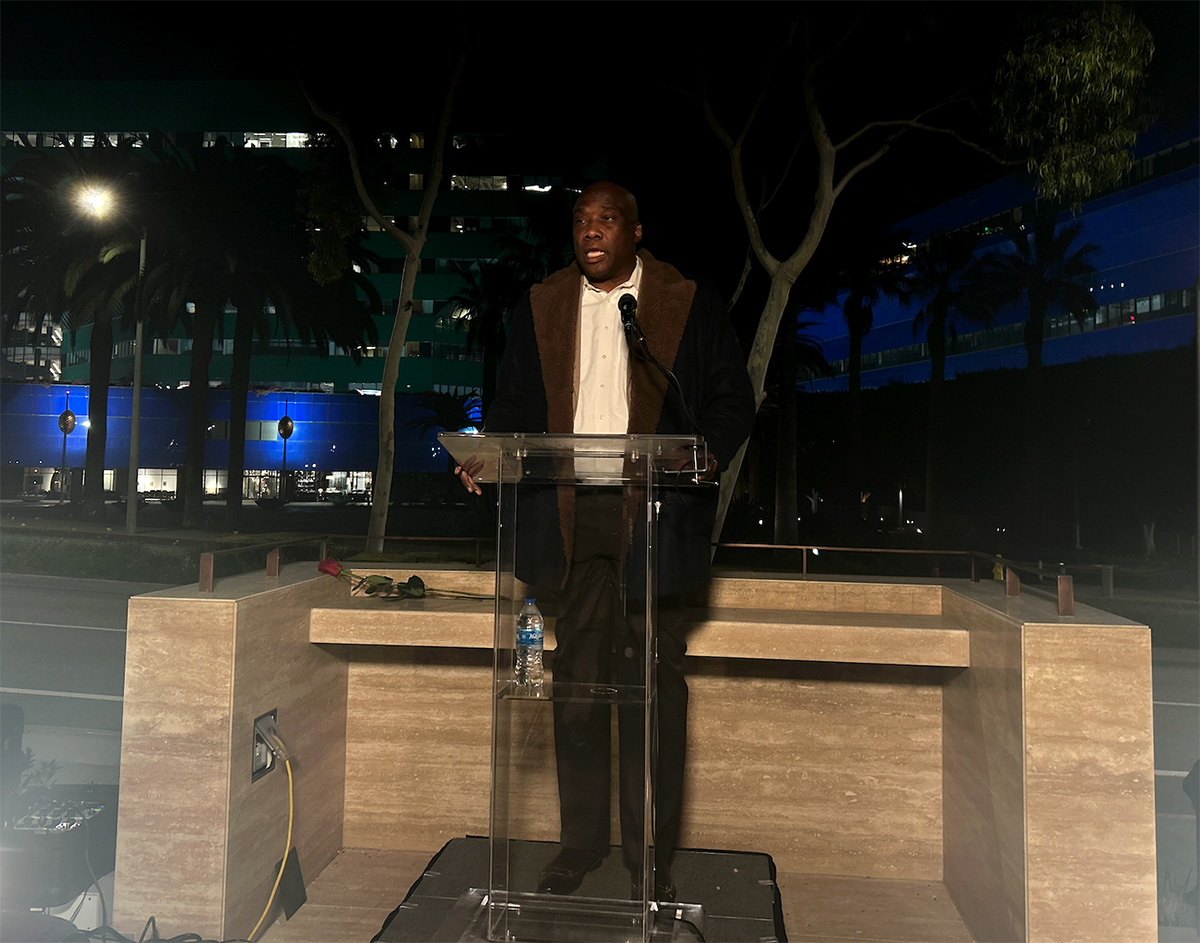
On Monday, the federal administration did not honor World AIDS Day, for the first time since the international awareness day was created in 1988. In addition to significant funding cuts to organizations focusing on HIV preventative treatment and care, the government’s halting of this commemoration perpetuates a dismissive system of inaction against LGBTQ+ people.
And yet, over 50 community members filled the empty spaces of West Hollywood’s AIDS monument yesterday evening, waiting in the night chill as city officials delivered impassioned statements and writers from APLA Health read personal pieces that centered a grief and love for those lost to the epidemic.
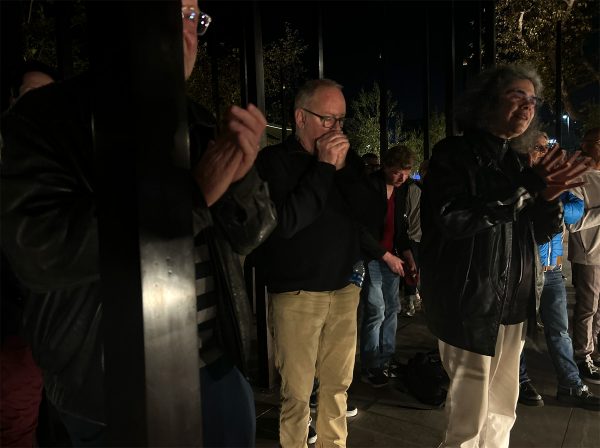
Before the readings began last night, West Hollywood vice mayor John Heilman asked for residents to join him in a righteous rage against administrative apathy. “I want to ask us all to reflect for just a moment about all of the people we lost…I want us to reflect and get angry,” said Heilman. “We have a fucking president who won’t even recognize World AIDS Day.”

Irwin Rappaport, board chair for STORIES: the AIDS monument, echoed this immense disappointment. “Many of us here tonight lived through the 1980s, so we know what that’s like,” Rappaport said. “We also know that because of that neglect, because of that lack of caring from the federal government, we have to care for one another — and we know how to do that. When we don’t have recognition from others, we know how important it is to preserve our own history, to tell our own stories.”
Through heavy silence, five writers from APLA Health’s writers group stood tall before a podium and shared intimate writings they created about the epidemic and its personal impact on them. The collective was established in 1989 to provide an inclusive, expressive space for HIV-positive writers and allies to work on their writing and learn how to share their stories.
Writer Brian Sonia Wallace, who served as West Hollywood’s poet laureate from 2020 to 2023, has been working with the writers group for the last four years to help them hone and refine their narrative voices as they share their heaviest grief and the depths of their love for the people they lost to HIV and AIDS.
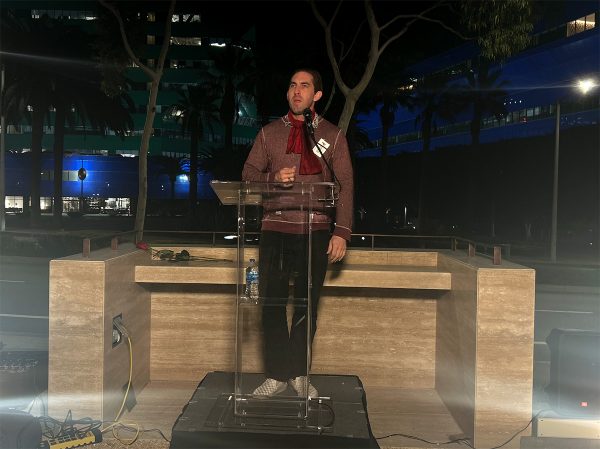
Hank Henderson, one of these writers, read from a diary entry from November 29, 1991. His voice, clear and strong, wavered as he shared about the death of his dear friend Richard. In a piece filled with lush, rich detail, painted clearly with a strong and loving voice, Henderson recounted a memory with Richard during the latter’s last years.
“The Santa Barbara sky is clear blue forever today…Yesterday came and went like a half-remembered dream between snooze alarms,” Henderson recited. “Last year, we walked to the beach. We spent hours there, played frisbee ourselves, brought the dog. Richard even yelled out 30-minute tanning turnover alarms. Yesterday, he took tiny, labored steps back to the car, used my shoulder to keep himself from falling over. Nobody said anything. We just pretend it’s normal.”
Another writer, Austin Nation, shared the story of being told he was HIV-positive at 26 years old. As a young nurse, he remembered the shock of seeing “young, beautiful men” arriving at the hospital covered in “purple, blotchy sores.” When he received his own test results, a paralyzing terror washed over his body. An incredulity followed the fear: why was this happening to him? “I got this thing for what?” Nation spoke. ”For having fun? For making love? And now it’s gonna cost me my life?”
But as he stood before the crowd, now 63 years old, he was met with applause and joy as he stated and repeated: “I’m still here. I’m still here.” The writers, in their grief and loss, have come to a place where they are able to share these stories, empowered and held. “In a world that writes off people with stories like mine,” Nation said. “It’s a hell of a good day to be alive.”
Kristie Song is a California Local News Fellow placed with the Los Angeles Blade. The California Local News Fellowship is a state-funded initiative to support and strengthen local news reporting. Learn more about it at fellowships.journalism.berkeley.edu/cafellows.
West Hollywood
West Hollywood kicks off community-focused programming for World AIDS Day
Since 1988, queer communities have come together on Dec. 1st to honor siblings and allies lost to the AIDS epidemic.

Since 1988, LGBTQ+ communities have come together on Dec. 1st to commemorate queer siblings and allies lost to the AIDS epidemic. This year’s World AIDS Day follows the theme “Overcoming disruption, transforming the AIDS response” and highlights the substantial funding cuts to research, health services, and community initiatives that have prioritized the safety of people with HIV and AIDS. The theme challenges people to think about “radical” ways to organize together and ensure that those who are impacted are able to access the care, treatment, and awareness that they need.
Beginning today, the City of West Hollywood is kicking off programming to recognize the historical transformation that local queer communities experienced during the AIDS epidemic. A panel from the AIDS Memorial Quilt will be available for viewing at the City’s Council Chambers at 625 N. San Vicente Boulevard through Monday, Dec. 15th.
Known as the largest community arts project in history, the Quilt is a powerful memorialization of loved ones who died during the epidemic. Each panel of the Quilt contains a story of remembrance, immortalizing a life cut short during the crisis. The project currently contains over 50,000 panels dedicated to over 110,000 people, all woven together in a 54-ton tapestry piece.
If you’re visiting the panel today, there will be an additional gathering opportunity tonight at the West Hollywood Park for STORIES: the AIDS Monument. From 5:30 to 8:30 p.m., members from the HIV-positive writers collective APLA Health Writers Group will present intimate readings that reflect on their experiences. Community members will be allowed time to wander through the monument and also preview the new Herb Ritts: Allies & Icons exhibition at ONE Gallery after the program. The art show includes striking black and white portraits of activists who stood in alliance with those most impacted during the AIDS epidemic.
Additionally, fresh flowers will be placed on the bronze plaques that line the City’s AIDS Memorial Walk. During the AIDS epidemic, West Hollywood was at the center of a rampant grief and loss that juxtaposed vibrant programming and efforts that boosted healing and fought against stigma and violence. It continues to be a vibrant space that houses various organizations and memorial spots that continue to uphold the revolutionary history and advocacy work that has continued since the epidemic’s beginnings.
Today, West Hollywood is in the process of executing its HIV Zero Strategic Plan, an initiative that began in 2015. Its goals include: expanding healthcare access for people living with HIV and AIDS, reducing the rate of infections, lessening health disparities and inequities for those impacted, and slowing the disease’s progress from advancing to AIDS.
According to West Hollywood mayor Chelsea Byers at a recent Cityhood event, the initiative carries forth the City’s “bold vision” and commitment to ensuring marginalized community members living with HIV do not face the life-threatening discrimination and health barriers that their elders experienced.
To learn more about the City’s programming, read here.
Kristie Song is a California Local News Fellow placed with the Los Angeles Blade. The California Local News Fellowship is a state-funded initiative to support and strengthen local news reporting. Learn more about it at fellowships.journalism.berkeley.edu/cafellows.
West Hollywood
Today, West Hollywood celebrates 41 years of queer cityhood
WeHo’s city officials are trying to preserve the fight for queer safety and rights that began decades before.
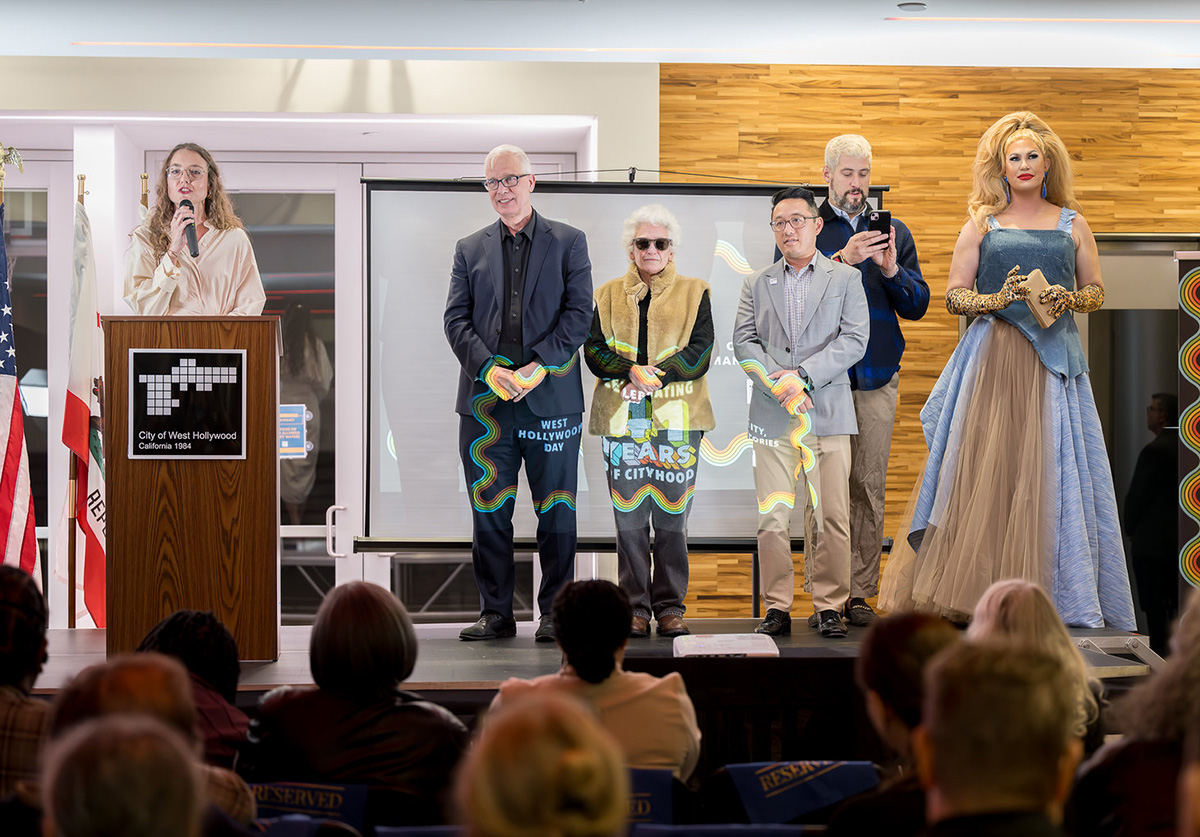
On Nov. 29th, 1984, West Hollywood was incorporated as an independent City, making its sovereignty official and solidifying it further as a sanctuary for LGBTQ+ community members, their stories, and their freedoms. Inspired by other prominent gay neighborhoods like New York’s West Village and San Francisco’s Castro District, West Hollywood was established by local queer advocates and residents. Their first city council was made up of a majority gay governing body — the first in the world, according to the West Hollywood History Center.
This political legacy, and the city’s vibrant and proudly queer history, continues to be preserved. On Monday’s celebratory event, West Hollywood mayor Chelsea Byers announced that the City’s current council “continues to be a majority-LGBTQ+ body,” holding tightly onto a “spirit” that reflects, prioritizes, and fights for Los Angeles’ queer community.
West Hollywood has been through various transformations, cocooning and revitalizing itself through the country’s evolving political and cultural upheavals. It has long been home to a ravishing nightlife that celebrates LGBTQ+ expression, and was a focal point for queer-led liberation and activism in the late 1960s and early 1970s. Trailblazers like Morris Kight led the first gay pride march through West Hollywood’s streets in 1970 and opened the Los Angeles LGBT Center to nourish the City’s robust and blossoming queer communities.
Today, West Hollywood continues to be the place where queer organizers and residents plant roots. Earlier this month, STORIES: the AIDS monument opened up in the City’s park after over a decade of work, shining a light on the legacies of gay activists, artists, historians, and community members who fought to survive as anti-gay stigma led to the erasure of their rights and lives.
As waves of anti-LGBTQ+ hate and violence continue to surge through the country, West Hollywood elected officials aim to continue doing the critical work that began decades before them: the work that protects the ability of queer residents to advocate for themselves, to live with protections and dignity, and to relish in joy. Mayor Byers is inspired by the resilience of the community members who stood together to establish this independent City in 1984. “The people who lived here…wanted a city with strong protections for renters, with progressive policies, and with a local government that would actually reflect and protect the people who call this place home,” said Byers, at the Nov. 24th celebration.
Over 40 years later, these needs have not changed. The way forward? Remembering and fighting for that initial promise and hope. “We are a chorus. We are a tapestry,” said Byers. “We are the product of thousands of people who, for more than four decades, have dared to say: We can build something better here.”
Kristie Song is a California Local News Fellow placed with the Los Angeles Blade. The California Local News Fellowship is a state-funded initiative to support and strengthen local news reporting. Learn more about it at fellowships.journalism.berkeley.edu/cafellows.
West Hollywood
From nickname to reality, the Rainbow District is made official by the City of West Hollywood
The mile along Santa Monica Boulevard from N. Doheny Drive to N. La Cienega Boulevard welcomes residents and visitors to come as they are
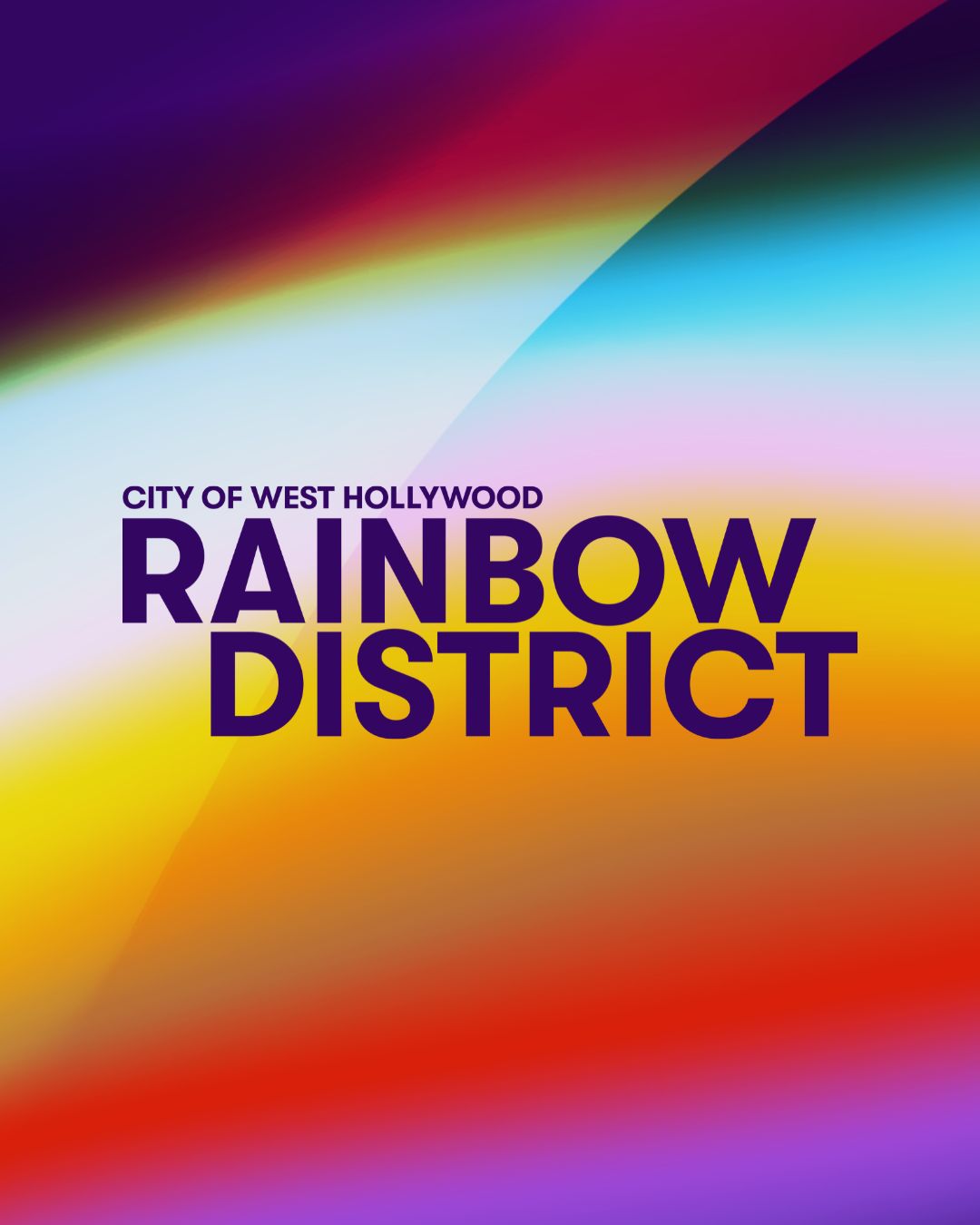
Even in today’s political climate, we will not be hidden.
The vibrant stretch on Santa Monica Blvd of over 50 local businesses, representing the full spectrum of LGBTQ+ expression, from N Doheny Dr to N La Cienega, has had the loving nickname of the Rainbow District for decades. Well, now it’s official. From nightlife to restaurants to community organizations, the City of West Hollywood has formally designated the space as such, honoring the neighborhood’s legacy as a safe haven for the queer community and beyond.
In addition to making the name official, the Rainbow District is being launched with a full range of social media, including Instagram, TikTok, and Facebook, keeping the residents and visitors updated on all upcoming events and happenings in the neighborhood.
Long known as a beacon of acceptance, inclusion, and visibility, where everyone is welcome, this iconic mile-long corridor is now formally recognized for what it has always been: a place where people from every walk of life can come together, be themselves, and celebrate the beauty of diversity.
City of West Hollywood Mayor Chelsea Lee Byers states, “For generations, the City of West Hollywood’s Rainbow District has been a place where LGBTQ+ people take their first steps into living openly, where the warm embrace of community is found at every turn, and where the joy of living out, loud, and proud fills the streets. The City’s official designation of the Rainbow District honors both the legacy and the future of this vibrant neighborhood, home to beloved entertainment venues, bars, and restaurants that have long served as cornerstones of LGBTQ+ life. Today, the Rainbow District is more alive than ever, and it will always stand as a beacon of hope, pride, and belonging and as a reminder that everyone deserves a place to celebrate joy, to be seen, and to be supported.”
The Rainbow District officially joins a nationwide list of iconic LGBTQ+ landmarks. West Hollywood will not be hidden amid political backlash and will continue to protect queer spaces, uplift queer voices, and foster a safe and joyful environment for all.
“This designation is not only a celebration, but it also serves as a promise,” said Visit West Hollywood President & CEO Tom Kiely. “A promise to keep LGBTQ+ spaces visible, valued, and vibrant for generations to come. As the Rainbow District continues to evolve, it will remain a place where locals and visitors alike can connect through culture, creativity, and community. The City’s formal designation affirms its significance and highlights The Rainbow District as the ultimate playground for travelers seeking a unique, inclusive, and authentic experience.”
The Rainbow District will be home to upcoming community events that include:
- Winter Market & Ice Skating Rink — December 2025
- Go-Go Dancer Appreciation Day — March 2026
- Harvey Milk Day — May 22, 2026
- WeHo Pride Weekend & the OUTLOUD Music Festival at WeHo Pride — June 5–7, 2026
Follow the Rainbow District on socials to discover local happenings, support small businesses, and be part of a neighborhood that celebrates every person for exactly who they are.
Instagram: @RainbowDistrictWeHo TikTok: @RainbowDistrictWeHo
Facebook: facebook.com/rainbowdistrictweho More Info: visitwesthollywood.com/rainbowdistrict
West Hollywood
West Hollywood’s AIDS Monument preserves the pain and power of people lost to the crisis
STORIES: The AIDS Monument is now available to view at West Hollywood Park, 15 years after its conception.

It was 1985, at the height of the AIDS crisis, when Irwin Rappaport came out as gay. As he came to terms with his identity, he witnessed people around him grow weaker: their faces becoming gaunt, painful lesions developing on their bodies. Five years later, he began volunteering as a young lawyer at the Whitman-Walker Clinic, a community health hotspot in Washington, D.C. that created the first AIDS hotline in the city, opened homes for patients with AIDS, and distributed materials that promoted safe sex.
The work being done at the clinic was instrumental, essential, and deeply painful. “When you see that sickness and experience that death among your friends and people you know, and when you’re writing wills for people who are much too young in ordinary times — it has an impact,” Rappaport told the Blade. “And even though in 1996 we saw life-saving medications come around, you never forget the sense of fear that permeates your life. The sense of loss.”
Determined to honor and share the legacies of people who died from AIDS, Rappaport joined the Foundation for the AIDS Monument (FAM) board to work towards the organization’s goal of creating a physical monument dedicated to memorializing these histories. FAM treasurer Craig Dougherty first conceived of this project in 2010 and, after 15 years, STORIES: The AIDS Monument is now available to the public for viewing.
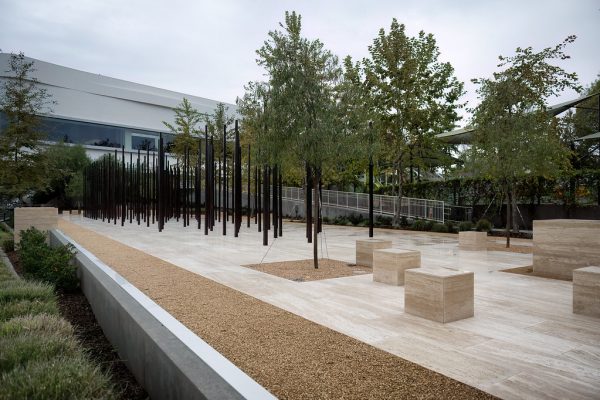
Created in collaboration with the City of West Hollywood, STORIES: The AIDS Monument is composed of 147 vertical bronze pillars known as “traces.” Designed by artist Daniel Tobin, 30 of these traces are engraved with words like: activism, isolation, compassion, and loss, which correlate to the over 125 audio stories collected and archived on the foundation’s website. This multimodal storytelling allows people who come across the monument to engage more intimately with the people represented by these physical pillars.
At nighttime, lights transform the monument into a candlelight vigil, providing a warm glow to a wanderer’s journey through the structure.
When people were able to walk around the traces at Sunday’s grand opening ceremony at the Pacific Design Center, the last remnants of the weekend’s rainstorm created a kind of “spiritual” and reverent atmosphere for those gathering, according to Rappaport. “I think there’s a certain peacefulness and serenity about the design, an opportunity for reflection,” he continued. “For some, it may bring back incredibly painful memories. It might bring back wonderful times with friends who are no longer here. It might remind them of their own caregiving or activism, or the sense of community that they felt in striving with others to get more attention to the disease.”
Now that the monument has been built, FAM has passed the mantle of management and programming to One Institute, a nonprofit that engages community members with queer history through panels, screenings, and other educational initiatives. One Institute plans to host monthly docent tours, art installations, and other special events during various LGBTQ+ national awareness days, including the upcoming World AIDS Day in December.
Rappaport also hopes to do outreach with local schools, so that young students are able to engage with the monument, learn about the people who were affected by the AIDS crisis, and interact with the ripples of transformation that this time period sparked in politics, research, the arts, and within society. “For younger people, I think [this is] an invitation for them to understand how they can organize about issues that they care about,” Rappaport said. “[So] they can see what the HIV and AIDS community did as a model for what they can do to organize and change the world, change culture, change law, change politics, change whatever they think needs to be changed. Because we had no other choice, right?”
West Hollywood
West Hollywood invests $1 million to build LGBTQ+ Olympic hospitality house
Pride House LA/WeHo will be an interactive space for queer athletes and allies to celebrate the 2028 Summer Games together.

The first-ever Olympic hospitality house began with humble roots in 1992: a tent pitched on the Port of Barcelona for athletes to gather with their families. Since then, they transformed into fixtures of several major sporting events, with hopes of fostering belonging and safety for athletes of various cultural backgrounds.
It wasn’t until 2010 that the first LGBTQ+ hospitality house, the Pride House, appeared during the Winter Olympics in Vancouver. Over the years, its existence and visibility have faced barriers. During the 2014 Sochi Winter Olympic Games in Russia, Pride House International was denied from organizing its safe hub. The rejection was a blow to the visibility and safety that the organization was trying to promote and create for queer athletes. But this didn’t go unnoticed. International fans demonstrated quiet resistance, hosting remote Pride Houses in support of the Olympians who were barred from openly communing and celebrating together.
As Los Angeles prepares to host the Summer Olympics in July 2028, Pride House is coming back stronger than ever. In early October, the West Hollywood city council approved an agreement that would allocate $1 million to sponsor Pride House LA/WeHo as they prepare to build a temporary structure at West Hollywood Park for the 2028 Games. For 17 days, vibrant LGBTQ+ sports programming will fill the park’s grassy knolls.
Pride House LA/WeHo CEO Michael Ferrera detailed at a Nov. 1st Out Athlete Fund fundraising event that the team plans to build a concert stage to seat over 6,000 people. There will also be a museum that will take viewers through 100 years of queer Olympics history, viewing areas for people to watch the games, and a private athlete village for queer Olympians. “The dream of that is — imagine you’re an athlete from a country where you can’t be out,” said Ferrera. “You come here, and you can be safe and sound.”

As outlined in the city council agreement and stated by Ferrera, most of the programming will be free and open to the public, and in the heart of a neighborhood that many of the county’s queer residents recognize as their safe haven. “We’re centering this important event in West Hollywood Park where our community has come together for decades in celebration, in protest, to support each other and to live our lives,” Pride House LA/WeHo CEO Michael Ferrera wrote to the Blade. “There is no place that is more representative of inclusion and safe spaces.”
The City of West Hollywood is promoting this inclusion further by asking for local community members to voice their perspectives on the formation of Pride House LA/WeHo at West Hollywood Park. On Monday, a community conversation will take place at Plummer Park to encourage residents to help shape the cultural programming that will take place in the summer of 2028. Another conversation will take place on Nov. 21st at the City’s 40th anniversary of Cityhood event.
“We couldn’t do this without the generosity and partnership of the city of West Hollywood,” Pride House LA/WeHo marketing co-lead Haley Caruso wrote to the Blade. “We are so happy to help bring the Olympic spirit to West Hollywood while also providing the community a safe and entertaining venue to enjoy the Games.”
Head to PrideHouseLAWeho.org for more information
West Hollywood
Drag performers delight Carnaval crowds with demure and daring dances
The Halloween party is one of the most anticipated events for queer Angelenos.
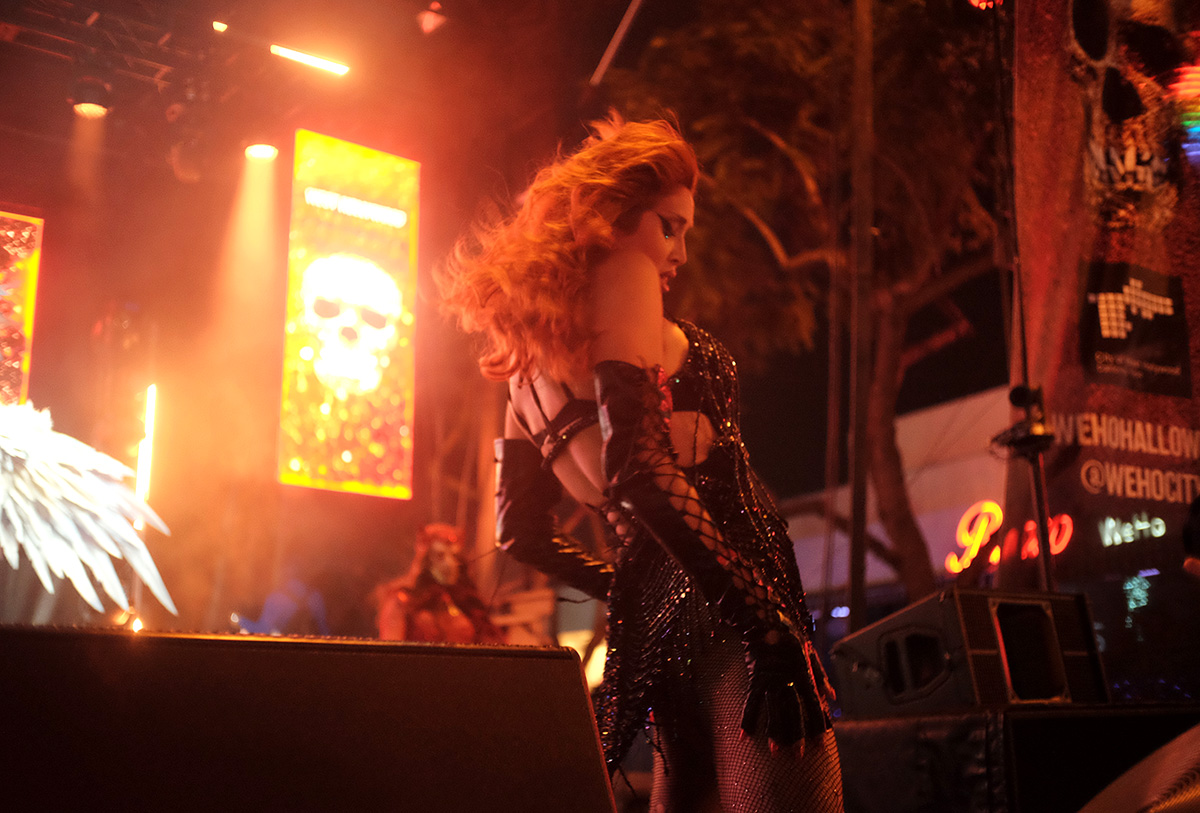
On Friday night, techno pop remixes surged through a tight block on Santa Monica Boulevard, where hundreds of eager partygoers danced near a pop-up stage. Bass-heavy grooves echoed across neighboring streets as Beetlejuices, angels, and vampires swayed and thumped to the beat.
Oct. 31 marked the arrival of West Hollywood’s annual Halloween Carnaval, one of the county’s citywide celebrations — and one of the most anticipated for queer Angelenos.
The first Halloween Carnaval was celebrated in 1987, and has since become one of the most awaited nights for local queer celebration. Drag performers donning elaborate costumes and glamorous makeup set the stage ablaze as they strutted, flipped their hair and danced to the cheers of a crowd that grew enormously as the night went on. The energy was infectious, and the Los Angeles Blade was on the scene to photograph some of these moments.
Image captures by Blade reporter Kristie Song.



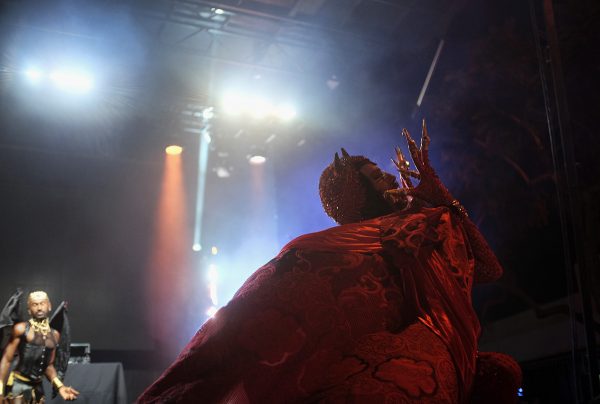
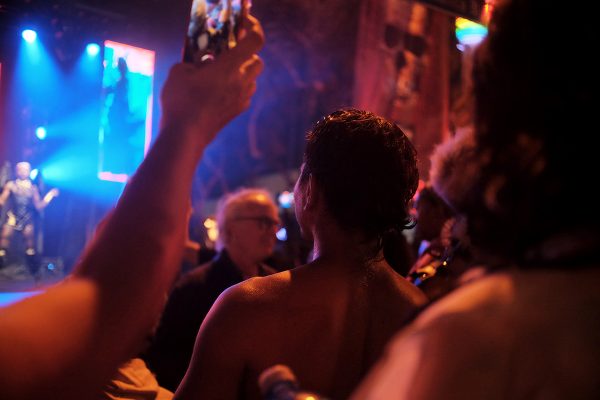
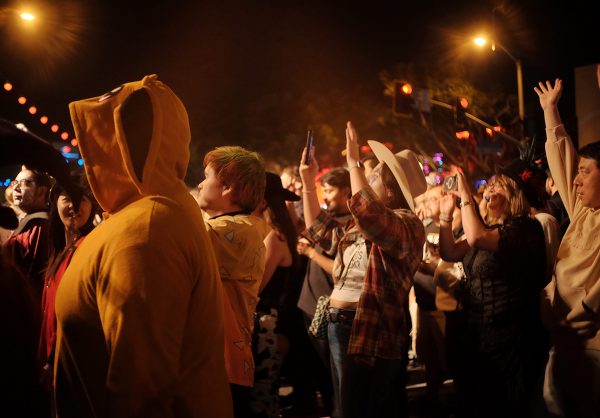

West Hollywood
West Hollywood installs new intersex pride flags on Intersex Awareness Day
On Sunday, city councilmembers gathered to raise two new pride flags to honor intersex community members
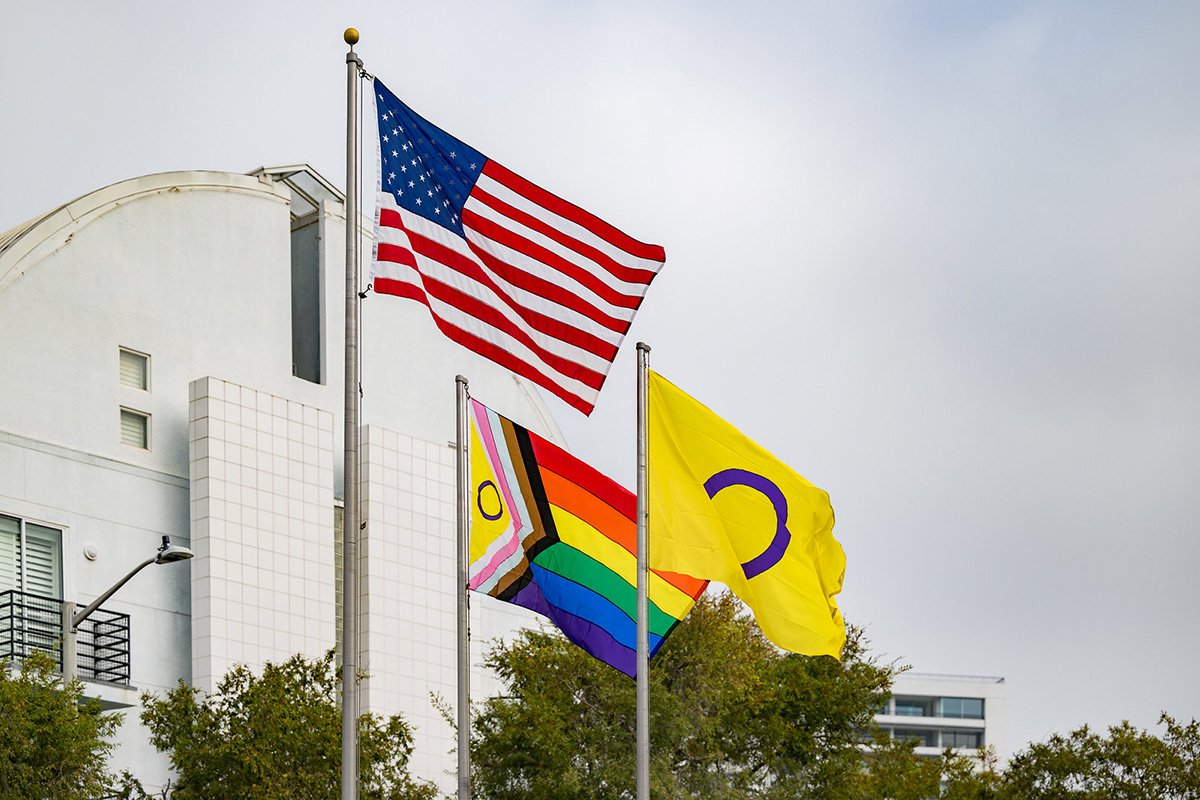
Early yesterday morning, on National Intersex Awareness Day, West Hollywood mayor Chelsea Byers, Vice Mayor John Heilman, as well as councilmembers Danny Hang and John M. Erickson gathered to install and raise two new intersex pride flags. They fly side by side with the American flag, upholding the City of West Hollywood’s vision of solidarity between national pride and LGBTQ+ visibility.
“We are facing unprecedented attacks on our community. It is important that we recognize the entirety of the LGBTQI+ community,” Vice Mayor John Heilman wrote to the Blade. “Intersex people have long been ignored and their issues disregarded. Raising the intersex flag also raises awareness about the challenges many intersex people face.”
Intersex people are born with naturally occurring variations in reproductive and sexual anatomy that don’t fit into binary “male” or “female” categorizations. As Planned Parenthood details, this can look like having both ovarian and testicular tissues or having combinations of chromosomes that aren’t “male” or “female,” just to name a few. According to the Human Rights Campaign Foundation, one of the biggest issues intersex people face is non-consensual surgeries performed when they are children. These operations are considered medically unnecessary and can leave lasting physical and psychological damage on intersex youth.
The fight for bodily autonomy and intersex visibility was the main reason behind the first action organized by intersex advocates and trans allies on Oct. 26th, 1996. Protestors stood outside the Boston Convention Centre, passed out leaflets, and spoke with clinicians, nurses, and other medical professionals attending the annual American Academy of Pediatrics conference.
One of the main leaders behind this movement was Morgan Holmes, an intersex woman who had experienced a violating medical procedure meant to “correct” her anatomy. In May of 1996, she presented testimony in a room adjacent to a symposium on genital surgery for intersex infants, a conference she and other members of her advocacy group had been rejected from.
“What I am saying is that my medical ‘care-givers’ failed to respect my autonomy or my intelligence when they assumed that because I was a child, they could do whatever they wanted as long as my father provided his consent,” Holmes said. “And when I began to balk, instead of questioning their own treatment of me, they blamed my body, and they cut it up.”
Today, intersex people and their stories are more broadly recognized, but still struggle to reach mainstream audiences when it comes to discussions around LGBTQ+ identity. West Hollywood city officials see this addition of intersex pride flags as a step forward. “Updating our city’s flags was my item because visibility matters,” councilmember John M. Erickson wrote to the Blade. “Intersex people have always been part of our story, and it’s time that their history, identity, and pride are recognized in the public spaces that belong to all of us.”
West Hollywood
Residents remain dubious as officials claim “no ICE involvement” at The Abbey
The Oct. 17th “undercover operation” was addressed at the latest city council meeting

On Friday, Oct. 17th, West Hollywood gay bar The Abbey found itself in the center of a social media storm as clips were shared depicting the presumed presence of federal Immigration and Customs Enforcement (ICE) officers. In a video posted on Oct. 18th by Charles Hernandez, who often creates content around gay nightlife in Los Angeles, several people are seen standing in a line as they are apprehended and handcuffed by officers wearing sheriff’s vests and tees. Hernandez noted that, while dressed in varying attire with the word “sheriff” on it, none of the officers were willing to identify themselves or present their badges upon request.
Hernandez can be heard asking the officers about the cause for arrest, to which one responded: “I don’t have to tell you our cause.” The video creator also questioned another officer, who can be seen wearing a gaiter to cover his face. “Isn’t it illegal to wear a mask in California?” Hernandez asked. “He has COVID,” an officer replied. In September, Governor Newsom signed five bills that weakened federal agents’ abilities to access school sites and health facilities, and prohibited them from hiding their identities. More specifically, SB 627 requires all California law enforcement agencies to create written policies limiting their officers’ use of facial coverings by July 1, 2026.
As this video circulated around the web, the West Hollywood Sheriff’s Station released an online statement of their own, denying allegations that the officers present were federal immigration officers. The station also claimed that the night’s events were a result of an “undercover operation” that was conducted in response to reports made about pickpocketing and the transportation, use, and sale of illegal substances. “Several arrests were made,” the statement read. “ICE was not involved.”
Still, residents remained unconvinced, criticizing the station’s lack of transparency, careful conduct, and accountability. Over 50 people took to the comments of this statement to voice their discontent. “[It] was not that long ago when officers would raid LGBTQ spaces and arrest people simply for being there,” one comment read. “A raid such as this does not inspire feelings of safety for our community. Especially in times when people are being kidnapped off the street by masked federal agents. There simply must be a better response to pickpockets and “other criminal activity” than undercover raids by masked officers and transporting detainees in unmarked vehicles. DO BETTER.”
Two days later, at the West Hollywood city council meeting, West Hollywood Sheriff’s Station Captain Fanny Lapkin took to the podium to address some of these concerns. Echoing the station’s Instagram statement, Lapkin confirmed that the “pre-planned operation” was created in response to “concerns from our businesses and our community in regards to the pickpocketing, to the narcotics, and also to the illegal vending and some of the criminal activity during illegal vending.” Lapkin also confirmed that no federal agents were present, stating that everyone who took part in the operation was “sheriff’s department personnel.” And because the arrests were made as part of a planned operation, Lapkin further stated that warrants were not “necessary.”
The events were discussed with brevity at the meeting, but community ire has not been dispelled. Several people continue to question the ethics of this undercover operation: Why were the individuals being arrested not clearly told the reason for their detainment? Why were unmarked vehicles present? Why conduct the operation in this way, as Los Angeles neighborhoods continue to stay on high alert over immigration raids? These questions remain unanswered as more specifics about the operation have yet to be released.
West Hollywood
Captain Fanny Lapkin wants more “transparency” between officers and WeHo residents
We sat down with the recently appointed captain to discuss her approach to LGBTQ+ community safety
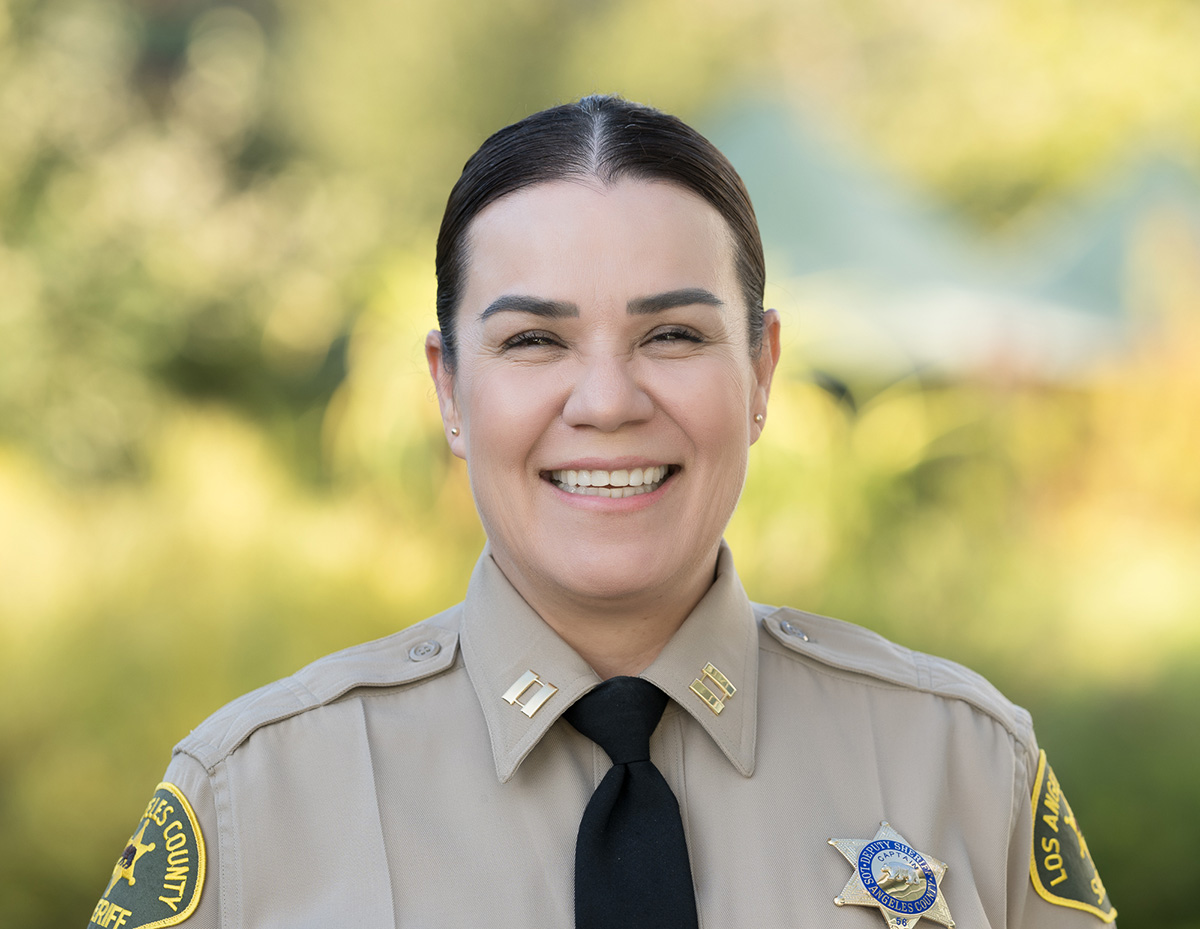
Before Fanny Lapkin became Captain of West Hollywood Sheriff’s Station in August, she was a longtime advisor and mentor for the county’s deputy explorer program: a training and career development opportunity for young adults interested in law enforcement. “I probably had eight or nine of — I call [them] my kids,” Lapkin told the Blade. When some of these mentees became deputies, she felt like a “mama.” Lapkin brings this nurturing approach to her leadership, where she hopes to build deeper community trust and humanize her staff members. “People have the misconception that we’re machines and that we’re robots. We are human beings,” said Lapkin.
Lapkin first ventured into law enforcement as a college student, where a casual walk into the East Los Angeles Sheriff’s Station for volunteer credit led to a seven-year-long stint. As a volunteer, she assisted deputies, participated in neighborhood watch, and became involved with safety measures for local community members. “I fell in love with the job,” said Lapkin. She officially took on a law enforcement role in 1997 and was eventually assigned to the Santa Clarita Valley’s Sheriff’s Station, where she worked as a community relations deputy.
In 2019, Lapkin began working at the West Hollywood Sheriff’s Station, climbing the ranks as service area sergeant to service area lieutenant before her most recent promotion to station captain in August. Lapkin says that she and fellow station staff pushed for LGBTQ+ inclusive curriculum for peace officer standards and training.
In September 2018, AB 2504 was passed, which required the state’s commission on peace officer standards and training to develop training material around LGBTQ+ identity and create inclusive workplaces. In 2024, AB 2621 was chaptered into law, which required the commission to also create and implement instruction on hate crimes against specific groups, including LGBTQ+ communities.
Today, Lapkin hopes to continue building trust with marginalized community members, especially LGBTQ+ individuals afraid to seek help through law enforcement. The Blade sat down with the captain to discuss her perspective and approach.
How do you hope to foster effective relationships between the sheriff’s station and community members?
Honestly, [it’s about] being available, being present. Joining Neighborhood Watch, having that open communication, making sure that you know the residents, whether it be from our LGBT community or visitors. We make sure that our deputies have the necessary training to be able to deal with different community members, whether direct leaders, whether business owners, or public safety commissions. Being available for them — I think that’s the number one thing, is just making yourself available to have those conversations.
Also, having that transparency — if something does happen, let’s talk about what happened. In some cases, we won’t be able to discuss for obvious reasons, but it’s having that open communication and making sure that our community feels that they’re safe and that their voice is heard.
It’s having the conversation: How can we come together to find a resolution for [issues]? People come from different directions to try and resolve a problem. So my thing is, everybody has a seat at the table. From being a volunteer to a deputy to moving up the ranks, I’ve always lived by that. I’ve had amazing mentors who have always had that open-door policy, [where] every community member has a seat at the table. Come and tell us what your concerns are, and we’ll tell you how we can fix them. There are going to be times when we cannot do something about it, because it doesn’t rise to the level of a crime. But we can tell you, without giving you legal advice, how you can try to resolve something.
How have you seen community issues and safety shift since you started working in the West Hollywood Sheriff’s station in 2019? How do you hope to address all of these shifts?
2019 kind of put us all in a bubble. But again, it’s just having that open communication and making yourself available, going to local events, participating in outreach, and just making sure that our community members, whomever they are — our Russian community, our Jewish community, our LGBT community — that they feel that they’re being heard, that we listen to them, and we understand that each of them have unique needs. So it’s trying to understand that and fostering a great environment where they’re comfortable enough to come to us, whether it be telling us how wonderful our deputies are, or also telling us they didn’t like the service that they received.
If I get a concern, [like] somebody saying, “Well, I don’t like the way this deputy handled the call.” I look at every single body-worn camera footage. I listen to the phone calls. And if it’s something that we could do better, we fix it, right? And if it’s something that maybe was misinterpretation…I tell [deputies]: take the extra two minutes to listen to our community, because you’re going to learn something by just slowing yourself down.
Unfortunately, our patrol deputies are under tight constraints. We are understaffed. They are working the extra overtime, but…we’re not machines, we’re not robots. We’re humans. And sometimes, the human nature kind of steps in at times. But we have to make sure that we teach them how to find the balance.
What are the unique needs and challenges West Hollywood communities face today?
The challenge is just making sure that our community trusts us [and] that our community is comfortable enough to come to us when they have a concern, when they’re victims. Especially with the LGBTQ community or even our transgender community, they’re a little nervous about going to law enforcement, or they feel that they’re going to be victimized again. That’s one thing that [we see] as a priority. We want to make sure that they don’t feel that, and that they do feel that they’re being heard, and that their safety is one of our concerns. We don’t care whether you’re LGBTQ, transgender, Jewish, or Russian — we’re going to treat you equally. If you’re a victim of a crime, we’re going to assist you and help you. I think we just want to make sure that our community members feel that they can come to us and we’re going to advocate for them, [that] we’re going to be a good partner.
What are the active ways that you and the station are building that kind of trust, specifically with LGBTQ+ and trans community members? How can they have that open dialogue with you and the station to feel safer?
Because there was a need for our transgender community…we started with a quarterly meeting, but we moved them to every six months, where we have a meeting and we invite any member of the community to come in and sit down and talk to us. We included our California Department of Justice partners. We included the trans Latina community. Our LGBTQ commission came out.
That’s something that we’re trying to figure out. What’s going to be the best time to have these open dialogues? It’s a town hall roundtable. Tell us what your concerns are, and we’ll tell you how we can fix them.
-

 Riverside County2 days ago
Riverside County2 days agoYesterday, Palm Desert residents shut down Councilmember’s “hateful” proposal to remove City’s Pride Month resolution
-

 Sports1 day ago
Sports1 day agoLA County contributes over $181K to Out Athlete Fund for Pride House LA/West Hollywood
-

 National2 days ago
National2 days agoAs house Democrats release Epstein photos, Garcia continues to demand DOJ transparency
-

 Business4 days ago
Business4 days agoLos Angeles Blade partners with the California LGBTQ Chamber of Commerce for 2026
-
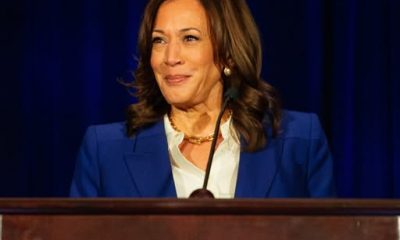
 Politics2 days ago
Politics2 days agoLGBTQ Democrats say they’re ready to fight to win in 2026
-

 Religion & Faith3 days ago
Religion & Faith3 days agoComing home to myself this Hanukkah in West Hollywood
-
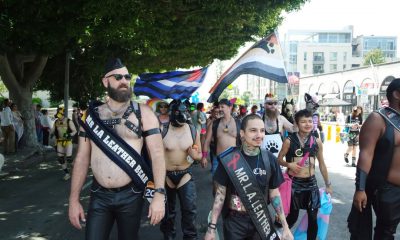
 Leather community5 days ago
Leather community5 days agoLegacy never looked so good: LA Leather Pride’s George Vasser talks titleholders past, present, and future
-

 Celebrity News4 days ago
Celebrity News4 days agoRob Reiner, ‘The Princess Bride’ director and outspoken LGBTQ+ ally, dies at 78
-
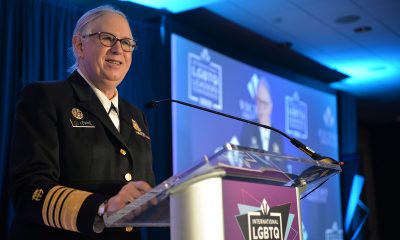
 National2 days ago
National2 days agoWhite House deadnames highest-ranking transgender official
-

 Events3 days ago
Events3 days agoLos Angeles Blade and matchmaker Daniel Cooley present a free gay holiday singles mixer



